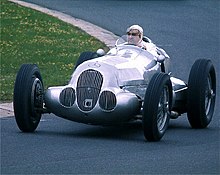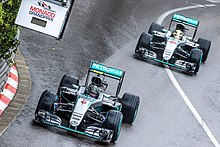McLaren Racing Limited is a British motor racing team based at the McLaren Technology Centre in Woking, Surrey, England. McLaren is best known as a Formula One chassis constructor, the second-oldest active team and the second-most successful Formula One team after Ferrari, having won 184 races, 12 Drivers' Championships, and eight Constructors' Championships. McLaren also has a history in American open wheel racing as both an entrant and a chassis constructor, and has won the Canadian-American Challenge Cup (Can-Am) sports car racing championship. McLaren is also one of only three constructors to complete the Triple Crown of Motorsport, a feat that McLaren achieved as a chassis manufacturer by winning the 1995 24 Hours of Le Mans. The team is a subsidiary of the McLaren Group, which owns a majority of the team.

Alfred Neubauer was the racing manager of the Mercedes-Benz Grand Prix team from 1926 to 1955.
Mercedes AMG High Performance Powertrains is a Formula One engine manufacturer, owned by Mercedes-Benz.
Throughout its long history, Mercedes-Benz has been involved in a range of successful motorsport activities, including sportscar racing, touring car racing, Grand Prix racing, and rallying. It is currently active in GT racing, and Formula One. Mercedes is also one of only three constructors to complete the Triple Crown of Motorsport, a feat that Mercedes achieved as both a chassis manufacturer and an engine manufacturer by winning the 1952 24 Hours of Le Mans.
Formula One sponsorship liveries have been used since the 1968 season. Before the arrival of sponsorship liveries in 1968 the nationality of the team determined the colour of a car entered by the team, e.g. cars entered by Italian teams were rosso corsa red, cars entered by French teams were bleu de France blue, and cars entered by British teams were British racing green. Major sponsors such as BP, Shell, and Firestone had pulled out of the sport ahead of this season, prompting the Fédération Internationale de l'Automobile to allow unrestricted sponsorship.

The Mercedes-Benz SLS AMG is a front mid-engine, 2-seater, limited production grand tourer developed by the Mercedes-AMG division of German automotive manufacturer Mercedes-Benz, with the assistance of David Coulthard. The car is the successor to the Mercedes-Benz SLR McLaren and was described by Mercedes-Benz as a spiritual successor to the Mercedes-Benz 300SL Gullwing, mainly because it was inspired by the latter. SLS stands for "Super Leicht Sport".

The Auto Union Grand Prix racing cars types A to D were developed and built by a specialist racing department of Auto Union's Horch works in Zwickau, Germany, between 1933 and 1939, after the company bought a design by Dr. Ferdinand Porsche in 1933. The Auto Union type B streamlined body was designed by Paul Jaray.
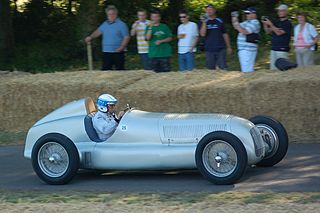
The Mercedes-Benz W25 was a Grand Prix racing car designed by Daimler-Benz AG for the 1934 Grand Prix season, in which new rules were introduced, and no championship was held. In 1935, the European Championship was resumed, and it was won by Rudolf Caracciola in a W25. In modified form, the W25 remained in use until 1937, when it was succeeded by the Mercedes-Benz W125.

Torger Christian "Toto" Wolff is an Austrian billionaire motorsport executive, investor and former racing driver. He holds a 33% stake in the Mercedes-AMG Petronas F1 Team and is Team Principal and CEO of the team.
Mercedes-Benz, a German luxury automotive brand of the Mercedes-Benz Group, has been involved in Formula One as both team owner and engine manufacturer for various periods since 1954. The current Mercedes-AMG Petronas F1 Team is based in Brackley, England, and possesses a German licence. An announcement was made in December 2020 that Ineos planned to take a one third equal ownership stake alongside the Mercedes-Benz Group and Toto Wolff; this came into effect on 25 January 2022. Mercedes-branded teams are often referred to by the nickname, the "Silver Arrows".

The Mercedes MGP W01 was a Formula One motor racing car designed and built by the Mercedes GP Petronas team for the 2010 season and was driven by the returning seven-time World Champion Michael Schumacher and Nico Rosberg.
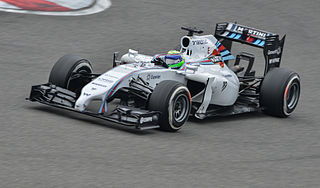
The Williams FW36 is a Formula One racing car designed by Williams Grand Prix Engineering to compete in the 2014 Formula One season. It was driven by Valtteri Bottas and Felipe Massa, who replaced the departing Pastor Maldonado.

The McLaren MP4-29 was a Formula One racing car designed and built by McLaren to compete in the 2014 Formula One season. The chassis was designed by Tim Goss, Neil Oatley, Matt Morris, Mark Ingham and Marcin Budkowski and was powered by a customer Mercedes-Benz powertrain. The car was unveiled on 24 January 2014, and was driven by 2009 World Drivers' Champion Jenson Button and debutant Kevin Magnussen, who replaced Sergio Pérez, after he won the 2013 Formula Renault 3.5 Series title.

The Mercedes-AMG GT is a series of 2-door grand tourers produced by German automobile manufacturer Mercedes-AMG. The car was introduced on 9 September 2014 and was officially unveiled to the public in October 2014 at the Paris Motor Show. While not directly replacing the SLS AMG, it is the second sports car developed entirely in-house by Mercedes-AMG. The Mercedes-AMG GT went on sale in two variants in March 2015, while a GT3 racing variant of the car was introduced in 2015. A high performance variant called the GT R was introduced in 2016. A GT4 racing variant, targeted at semi-professional drivers and based on the GT R variant, was introduced in 2017. In 2021, a new variant called the AMG GT Black Series was released. All variants are assembled at the Mercedes-Benz plant in Sindelfingen, Germany.

The Mercedes-AMG ONE is a limited-production plug-in dual hybrid sports car manufactured by Mercedes-AMG, featuring Formula One-derived technology. The Project One concept car was unveiled at the 2017 International Motor Show Germany by the seven-time F1 world champion and Mercedes-AMG Petronas F1 driver, Lewis Hamilton and Head of Mercedes-Benz, Dieter Zetsche.
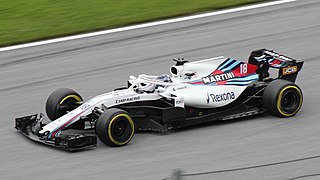
The Williams FW41 is a Formula One racing car designed by Paddy Lowe and Dirk de Beer for the Williams team, to compete in the 2018 FIA Formula One World Championship. The car made its competitive debut at the 2018 Australian Grand Prix, and was driven by Lance Stroll in his second season with the team; and Sergey Sirotkin, making his competitive debut in Formula One.
The Mercedes-EQ Formula E Team was a German racing team that competed in Formula E. The team made its debut at the 2019 Diriyah ePrix as part of the 2019–20 season. Mercedes concluded their involvement at the end of the 2021–22 Formula E World Championship, with the team being taken over by McLaren and returning under new ownership from the 2022–23 season.

The Mercedes W13, officially Mercedes-AMG F1 W13 E Performance, is a Formula One racing car designed and constructed by the Mercedes-AMG Petronas Formula One Team to compete in the 2022 Formula One World Championship. The car was driven by Lewis Hamilton and George Russell, the latter racing his first season with the team. The team’s reserve driver was Nyck de Vries, who usually drove in Formula E for the Mercedes-EQ Formula E Team. The chassis was Mercedes's first car built for the new ground effect technical regulations introduced in 2022. The W13 saw the return of the traditional silver livery, after the W11 and W12 were painted black in support of the Black Lives Matter movement, though the drivers continued to race in black overalls.

